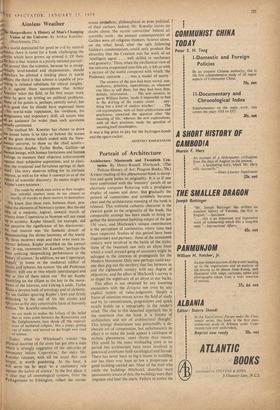Portrait of Architecture
Architecture: Nineteenth and Twentieth Cen- turies. By Henry-Russell Hitchcock. (The Pelican History of Art: Penguin Books, 70s.) A FIRST reading of this phenomenal book is decep- tive and quite belies its originality. It is as if one were confronted with the 'memory' panels of an electronic computer flickering with a prodigious display of names and dates. But gradually the pattern of connections and terminals becomes clear and the architectural meaning of the book is released. This withheld cathartic character is the clearest guide to the originality of the book. No comparable attempt has been made to bring to- gether the international building output of the last 150 years, and Hitchcock's unique contribution is the perception of continuities where none had been suspected. Studies of this period have been fragmentary and partisan: those of the nineteenth century were involved in the battle of the styles, those of the twentieth saw only an abyss from which a small pressed-gang of ancestors might be salvaged in the interests of propaganda for the Modern Movement. Only now perhaps could any- one dare peg out the territory that lies between us and the eighteenth century with any degree of objectivity, and the effect of Hitchcock's survey is to dispel the nightmare of an abyss at our backs.
This effect is not obtained by any knowing encounters with the Zeitgeist nor even• by any explicit system of value-judgments. Simply a frame of attention moves across the field of study and by its concentration, progressions and quick recalls builds up a topography in, the reader's mind. The clue to this detached approach lies in the statement that the book is 'a history of architecture and not of architectural thought.' This strange dissociation was presumably a de- liberate act of compression, but unfortunately its effect is to make the book appear a catalogue of stylistic phenomena, more rhyme than reason. This could be the more misleading since at no period has architecture been more involved in polemical ambitions both sociological and formal. There has never been so big a'boom in building, nor has there ever been so low a proportion of good building carried out. Most of the men who made the buildings Hitchcock describes were passionately aware of this; the buildings were their response and bear the mark. Failure to notice the
context makes strange history; failure to clarify the 'thought' makes superficial the study of style. Hitchcock's technique (and perhaps he has space for no other) is simply to point his finger at the buildings deserving attention; from that moment you are on your own. This entails considerable reference to other books; the power of his book is that this always proves to have been worth while.
The volume opens at 1800. This (presumably editorial) decision itself blocks any organic development of the theoretical subplot to the whole period, since the crucial breakaway from Baroque absolutism had begun earlier in the eighteenth century and achieved coherent formu- lation by 1750. Hitchcock is well aware of this and his Introduction makes a brave attempt to make up forbidden ground. But Kauffman's recent studies of this period, with their emphasis on the crypto-revolt of Vanbrugh and Hawksmoor, give reason for some radical reconsideration of the stylistic roots of modern architecture, and it is at this point that Hitchcock's chosen treatment should rightly begin, all the more so, perhaps, in view of the extraordinary emergence of Anglo- Saxon leadership that forms a major section itself of his book. For of the two formative theses that underlie the work of this period, English Empiri- cism is the lesser known. The line from Boffrand and Laugier through the French Revolutionary architects up to Le Corbusier is comparatively clear. But the line from Robert Morris through Burke and Hume to Neo-Gothic and thence to Lloyd Wright contains complexities upon which Hitchcock throws sudden shafts of light but no developed interpretation.
The treatment of the difficult central period of the book (1850-1900) is the most valuable. After digesting rich helpings of Second Empire and High Victorian Gothic, Hitchcock surprisingly
raises Norman Shaw ('an architectural Picasso'!) to primacy in a chapter of great originality. Next the spread of Shavian influence involves a shift to the increasingly significant arena of the States where it is countered by the comparable stature of Richardson and Stanford White. This focus upon Anglo-Saxon activity is sustained to the end of this section by two excellent chapters on the development of domestic and commercial archi- tecture. Clearly English architecture stands to gain more than any other by such a revaluation of this period.
In Part Three (1890-1957) the survey becomes self-confessedly more personal from the Twenties onward, but on the whole it is balanced and re- mains unique in that, although a 'success-story,' it is not written as propaganda. Here again one Must note that the omission of some theoretical and sociological background could be doubly mis- leading in playing down the intrinsic passion for system-building of these men, most of whom were teachers and propagandists as well as practitioners.
With exceptional fairmindedness the 'so-called Traditionalists' have an erudite chapter of civil burial. The final chapter on the nineteen-fifties has great breadth but inevitably some blindspots (no Aalto, no Bakema); strangest of these is the total omission of Louis Kahn, the one American 'original' to appear on the scene since the war.
On balance this is a magnificent and unique survey of building form during a complex period and requires only a little amplification to make it stand on its own feet as a masterpiece. First, a short but explicit chapter in each part on the theoretical framework; second, plans which are better drawn and show not just snippets but whole











































 Previous page
Previous page